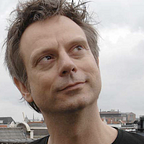The future cities in the countryside in the city
Last Wednesday I attended an edition of the Facing Forward lecture series. Topic of this one was future city and two keynote speakers shared interesting views. China Miéville is author and professor and for me most known of his wonderful book The City & The City that predicted the state of the current cities with different populations living together and ‘unseeing’ each other at the same time. Check this analysis of Nicolas Nova.
Rem Koolhaas was the second keynote, he needs no introduction; he is maybe the most famous architect of our times.
The two talks differed a lot in form. Miéville did a formal lecture, with some slides to underline his scholarly statements. Koolhaas used a lot of architectural visual analysis to build his point that the countryside is an important and neglected part of the discussion on the city. His talk was provocative in the subject but rather straight forward in the form. More accessible and fun. Miéville’s talk was the contrary; highly conceptual and well-spoken, with more constructed theory.
I am not aiming to do a report in any way. On Storify I collected some of the quotes that gives an impression. What I like to focus on is one aspect that was touched in the panel by the chairman, Christoph Lindner. Both speakers refers on the impact of our data driven world in the landscape. Miéville talked on the data building in the heart of New York City that was made famous by Kevin Slavin in his algo-talks. And there are will be more. Koolhaas mentioned the data farms that are not hiding anymore in the countryside.
One of the things of the talk of Miéville showed us how cities are more of a decor for our living, a set where we live in, highly planned and composed to leverage our consumption. There is a disconnection with the original city concept in the city in that sense.
Koolhaas asked himself how city behavior is taken over typical country sides. Like farmers that behave more and more like office workers behind the computer. In the way the space is used there is hardly any difference, he showed us. A bit constructed, interesting though is the way modern flex workers are entering the countryside because in our service economy people are unconnected from the city.
The necessary connections between people that makes citylife prosperous, is replaced with the digital layer we build on our own lives, or integrated in our relations. After hearing the two talks I felt this story emerge: the disconnection of our physical presence and behavior and our virtual layer we all integrate. In the virtual cities we shape and where we live most of our times, we need frozen spaces where we organize frictions with each other, both in the city as in the countryside. The differentiation will not be between the city and the countryside but between the planned context and the open context. We fill in the open spaces with our own virtual layer. In that virtual space we are building the real future cities. And therefore I strongly agree with Lindner that the virtual data space was the angle that missed in the talks on the future city.
